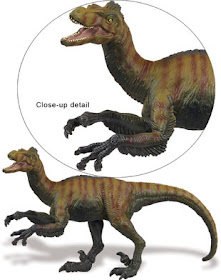
As a child of the '90s, what is most fascinating about dinosaur books from the era is comparing exactly what has stood the test of time and what hasn't. This is particularly (although not solely) true of theropod restorations, quite a few of which have subsequently been subjected to a huge paradigm shift. Tellingly, many of the beautiful models and illustrations featured in The Ultimate Dinosaur Book actually stand up to modern scrutiny very well, with only a few comparatively minor faults (for example, the pronated forearms on the front cover Allosaurus). As always, because of the huge choice available, I've tried to go for some of the more dated, quirky and therefore interesting models/illustrations in the book. Like this one...

Say hello once more to early '90s 'carnosaur' Spinosaurus, whom we have encountered before. In fairness, however, David Lambert's text does note that this restoration is based on the work of Stromer, and that "the head may have been lower than Stromer thought" - other illustrations on the page show a more modern-looking, long and low snout. They all have the bizarrely four-fingered hands, though, likely based on Stromer's original monograph. I don't know why Stromer originally restored the animal with four fingers rather than three, but have a few ideas - if you happen to be a bit more informed then (as always) please do drop us a comment.

Poor old T. rex always seems to get a bit of a bum deal in these '90s books. While the model is mostly very good for the time, even as a kid the eyes struck me as being bizarrely huge. This, combined with the big ol' cute-puppy pupils, makes the big toothy one look all cuddly wuddly. Aww, bwess his piddly li'l twiggy arms. The same applies to the 'front view' head on the left, too. A look straight down the business end of Tyrannosaurus is intimidating enough when one is just looking at fossil bones (or, er, casts), but the oversized peepers make it look positively adorable.

Obligatory 'tee hee! They thought dromaeosaurs were scaly in the '90s!' Deinonychus pic for you. This model can actually still be viewed in London's Natural History Museum, where it's correctly placed in context with a lot of other outdated models, unlike certain other inaccurately naked Deinonychus. This image gains extra poignancy for having a 'scaly skin' label attached to it in typical Dorling Kindersley style. Of course, much like the miniature Crystal Palace-style Iguanodon figures that it sits next to in the Natural History Museum, this is still a beautifully sculpted work of art.
Speaking of outdated scaly deinonychosaurs, The Ultimate Dinosaur Book features a Troodon profile and, oh yes, that daft anthropomorphic freak from a David Icke slideshow is present and correct.

This one's especially for Trish. Poor old Dale Russell - apparently he feels a bit embarrassed if one brings this up with him nowadays. We forgive you, Dale. This image and its accompanying text are funny for a couple of other reasons - firstly, because a lot of the labels seem somewhat superfluous (toe? Foot? Really?), and secondly because the text literally describes Troodon as 'bird-like' before going on to say that Russell (sorry, sorry!) believed that this bird-like animal might have evolved into a humanoid creature. Oh dear. Time to move on to something a little less cringeworthy.

Yes, there are a number of things wrong with this picture of the therizinosaur Segnosaurus by modern standards (for one thing, it's another bald maniraptor), but for 1993 this is amazingly good. The foot with four well-developed toes - none of which are webbed - long neck with small head, and large hand claws are all present. Lambert even accurately speculates that the animal was most likely a strange, herbivorous theropod. Given that therizinosaurs were so poorly known at the time, I think The Ultimate Dinosaur Book is remarkably prescient. Its only bizarre slip-up is in placing this guy at the end of the sauropodomorph profiles section. Huh.

Two-fingered Compsognathus! That particular idea stuck around for quite a long time, with even the creatures in The Lost World: Jurassic Park having only two digits per hand. While, of course, the animal is now known to have the more usual three fingers, this model is notable for having the hands oritentated correctly. Whether by chance or not, I don't know, but it's still a plus point.
Oh dear - it appears that I've been far too biased in favour of theropods again. Typical. Here, have a ceratopsian.

This, of course, is Styracosaurus - and it's a rather good one at that. I've included this to draw attention to something that was acceptable back in the day. but isn't anymore - namely, giving ceratopsians elephantine feet. As I pedantically pointed out just last week, this is actually now considered inaccurate - ceratopsians had quite distinct, separated digits on both their hands and feet, actually retaining quite primitive characteristics in this respect. Still, I will once again say that the model pictured above remains quite lovely - I am especially fond of the colours, which I believe have been ripped off in dinosaur toys (and quite right too).
And now for an unceremonious end to this post. That's your lot for the time being! Although there's bound to be more in the future, unless DK's lawyers send me threatening e-mails. Given that these models were actually used across a range of DK books, I've hopefully brought back a few fond memories for you nonetheless.
























